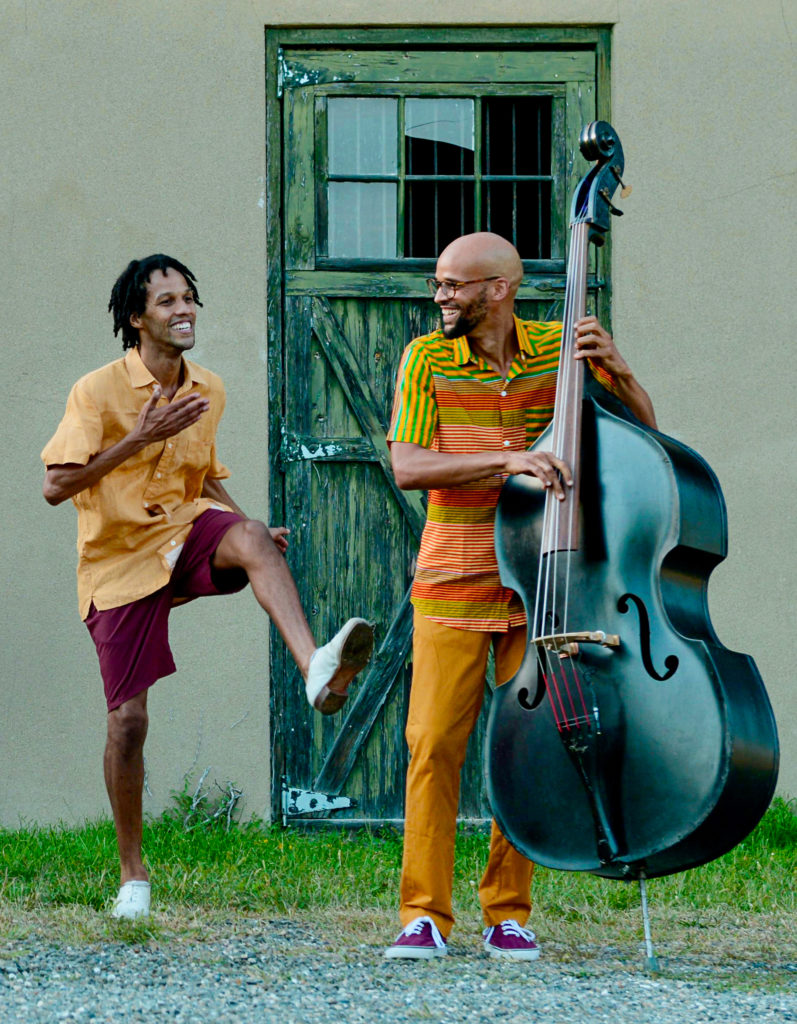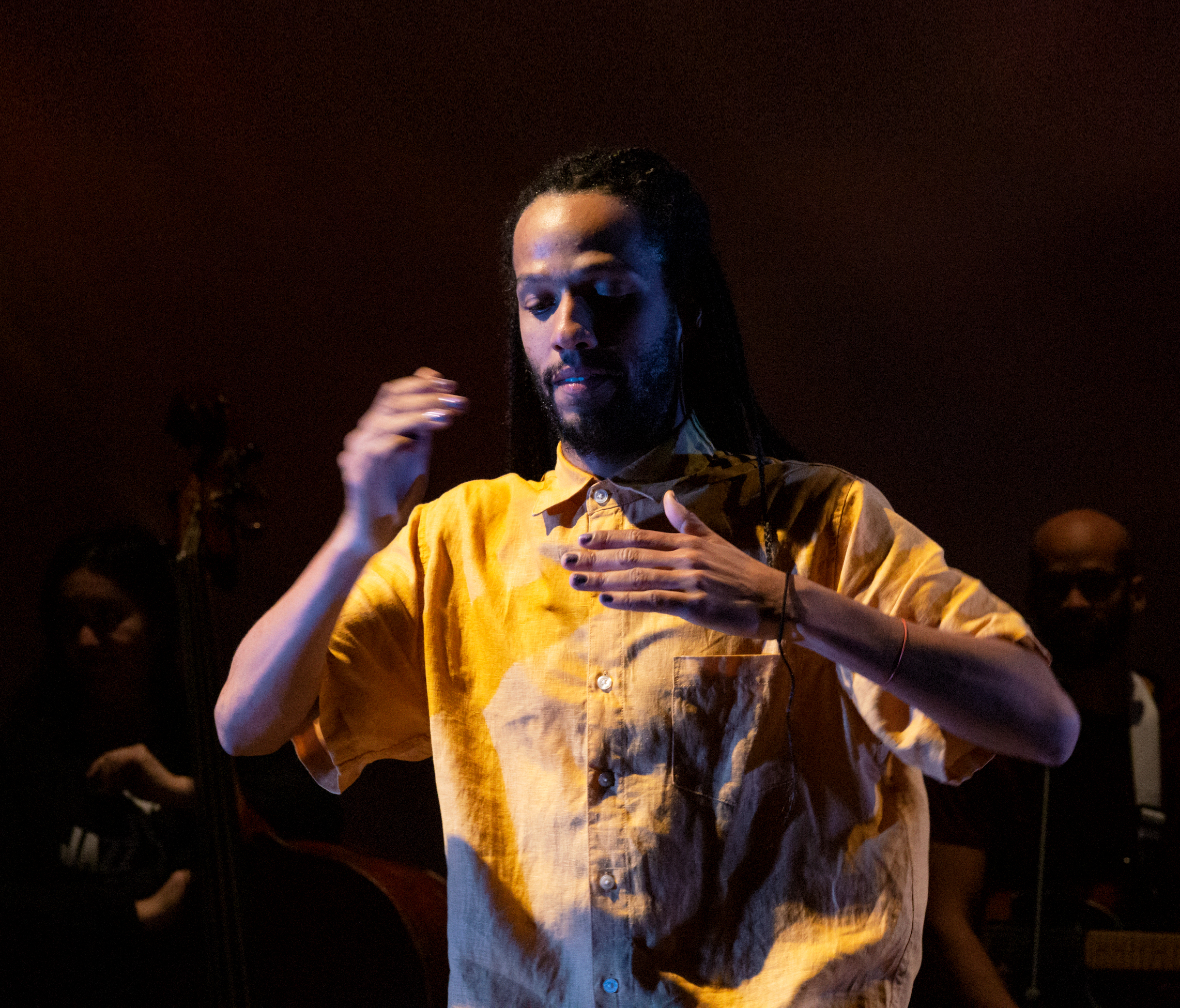The Origins and Influence of Body Percussion
Crash. Bump. Thump. Thwack. Whack. Knock. These are a few of the many synonyms of the word “percussion.” All of them are appropriate when we look at the ways world cultures use the body as an instrument.
On a recent television quiz show, contestants were challenged to name body parts that could be used as a drum. No one made a mistake because nearly every part of the body can become a sound maker. Clapping, stomping and striking body parts from head to feet in rhythmic or repetitive ways is a timeless means of human interchange, whether for pleasure, protest, entertainment, ritual, healing or survival. Hand- and body-clapping children’s games accompanied by sung or spoken rhymes are common around the world. To promote healing and as an antidote to anxiety, pain and stress, the contemporary alternative-medicine practice EFT (Emotional Freedom Technique) involves gentle, repetitive tapping on specific head and body pressure points. Enslaved Africans used body percussion as furtive communication—fearful of its messaging potential, plantation owners prohibited the use of drums, and to sabotage this taboo, the Black body became the drum.

The Power of Percussion
The juba dance, brought to the Americas in Middle Passage—the grueling sea journey of Africans captured from their homelands to live enslaved on foreign territories—was performed during plantation gatherings. In this dance of prowess, one person entered a circle of movers to exhibit their extraordinary variations on jig, hop and jump steps and was joined by a second dancer as the outer circle alternated rotating and remaining stationary. Pattin’ juba, the juba dance accompanied by clapping hands, chest and thighs, and the juba song—composed of short, rhymed verses that seemed like nonsense but carried double meanings—were ingenious later adjustments made to accompany the dance and send messages when drums were banned. Pattin’ juba further morphed into the hambone, a variation that centers on body percussion and is performed standing in place or seated, while retaining the original rhythm of the dance. Multiple verses, sung and clapped or patted rhythmically, may begin with:
“Hambone, hambone, where you been?
Round the world and back again.
What you gonna do when you get back?
Take a little walk on the railroad track.”

A five-beat interlude of rhythmic slaps on body parts including the chest, hips, thighs and calves intersects each singsong stanza, and a host of other improvised refrains can be added. For Rennie Harris, legendary hip-hop concert dance choreographer and artistic director of Rennie Harris Puremovement and RHAW (Rennie Harris Awe-Inspiring Works), hambone was second-nature: “I don’t remember exactly when I learned or who taught me. In fact, I don’t even remember seeing it or being introduced to it—I just remember doing it,” he says. “I was 7 or 8 years old; this was on Master Street in North Philadelphia. We used to sit on the stoops and challenge each other, doing the hambone, seeing who could do it the fastest, cleanest. It was a summer pastime. We sang the song, as well. Being older, I’d run into people who still do it, so it’s kind of interesting and cool. We’d add parts of it to dance steps. I didn’t learn the history of it, pattin’ juba, until later in life.”
What Harris describes is how cultural traditions are preserved and transmitted—younger generations watch, imitate, practice and improvise to make them their own. Harris’ stunning version is a unique rendering, infused with the speed, passion, urgency and aggressive power of Black male agency two centuries later. We also see the hambone legacy in stepping performances by Black fraternities, sororities and step teams, and as a diversion added to a variety of social events ranging from white Appalachian hootenannies to Black jazz or blues concerts, complete with variations on the words and improvisational hand-jive styles. It has become an American tradition.
Spreading the Rhythm
The basic hambone beat got a second life in the world of popular music. The 1950s R&B legend Bo Diddley made the five-accent hambone rhythm famous as the Bo Diddley Beat, a recurrent riff that has been appropriated by many white rock musicians.

Tap dance, another style of body percussion, has impacted almost every culture. Using toes, heels and the full foot in rhythmic fashion goes beyond any one era or continent and includes traditions as diverse as African American buck dancing, Irish step dancing, English clogging and South Indian bharatanatyam. Beyond those traditional examples, the complex, polyrhythmic fusion of tap, combined with hambone-inspired body percussion, has proliferated with present-day artists across continents. The South African gumboot dance was transformed into a performance mode from its goldmine workforce origins, where it was created by Black miners as a sly replacement for conversation, since the white mine owners exacted harsh punishments for verbal communication among the workers. Other spinoffs include ensembles like Colombia’s Tekeyé; The Percussion Show, from Egypt; and the U.S.-based Music From The Sole, which draws on Afro-Brazilian influences. These artists transform a combination of tap and hambone to a glorious, millennial sensibility through the lens of hip hop and jazz.
The art of flamenco includes a special kind of tapping—zapateado—as well as body-percussion elements that resonate with hambone. “Flamenco was being born in the mid-19th century. Certainly, by the 1902 arrival of the cakewalk in Spain, Black dance cultural motifs were transmitted, and flamenco artists expressly emulated Black American dance,” says Dr. K. Meira Goldberg, author of Sonidos Negros: On the Blackness of Flamenco. “New forms that were created in explicit response to competition from Black artists in Spain emphasized percussive footwork, and over the past 30 or so years flamenco footwork techniques are increasingly influenced by tap and hip hop. It is fair to say that other modes of body percussion (hambone, or making percussion by snapping fingers, clapping hands or hitting hands on various parts of the body mixed with footwork) are also increasingly emphasized. Flamenco is always ready to absorb new performative ideas, and these ideas are reinterpreted and reinvented: In Spanish, the saying is ‘Llevarlo a tu terreno,’ or ‘Make it your own.’ ”
Contemporary flamenco dancers, like the intriguing El Yiyo, have evolved a style that, like Harris’, is as speedy as the internet, as intense as a lightning bolt, and lives in the present while standing proudly on the shoulders of tradition. Goldberg adds that in the country-bumpkin dance within the 17th-century Spanish tradition of villano, the dancer “not only stomps and jumps but also slaps the sole of his shoes with his hand.” Examples of this style, often associated with Roma stereotypes, include the Moiseyev Ballet Company’s Dance of the Bessarabian Gypsies. In addition to their characteristic squat-kicks—kazatskys—the male dancers leap high while clapping hands, striking thighs and heels, and thumping their chests. As in the Spanish bumpkin dance, body percussion in the villano is associated with the stereotypical “wild abandon” of an outsider culture—namely, in the flamenco context, the Roma.
Indonesia has its share of corporeal clapping traditions as well. The Saman (“dance of a thousand hands”) of the Gayo ethnic group of Aceh, Sumatra, is known across the island and performed by large groups to celebrate special occasions. Dancers sit on the ground with their legs crossed or folded beneath them, torsos upright. Though there are also mixed-gender performances today, ensembles had traditionally been separated by gender: Women do gentle tapping or patting on chest and thighs accompanied by hand-clapping, singing and rhythmically moving the torso and head, while the men move vigorously and their taps become slaps. The Saman performance peaks as the dancers accelerate to the fastest possible pace while maintaining clarity of sound and cleanness of movements.

Embracing the Legacy
Exploring body percussion reinforces the understanding that everything we humans create has roots in something that went before. Even the most sublime innovations have a precedent. As Harris declared years ago, hip hop is “the contemporary form of African dance.” Similarly, Goldberg’s research delves into the manifold, often invisibilized, roots of what is now flamenco. The concealed riches of “the before time” have become available on a global basis, thanks to social media, YouTube, streaming platforms and international touring by artists of every origin.
Interestingly, hip-hop movements and music act as a unifying factor crossing cultural, class, racial and economic divides, transgressing differences, blurring boundaries and allowing a current generation of artists to travel beyond the assumed limitations of their genres, to try new things and experience other realms. From hearts pumping, lungs breathing and blood pulsing to pounding feet and slapping palms, bodies are effective beatboxes and rhythm makers. Despite all odds—and beyond our wildest expectations—we still have our beatbox bodies, and we can boldly declare, “In bodies we trust.”





